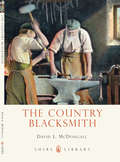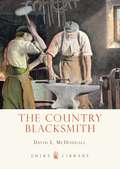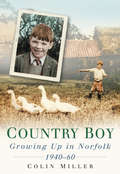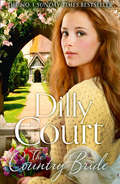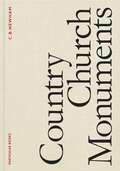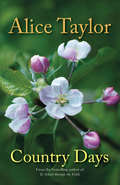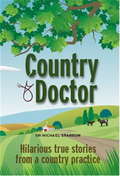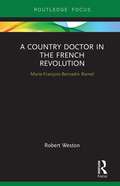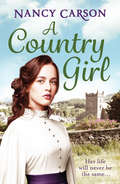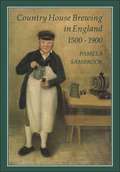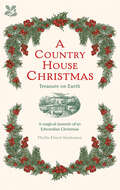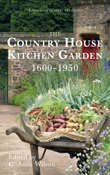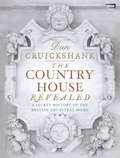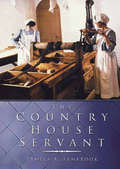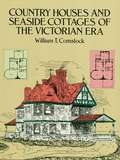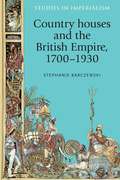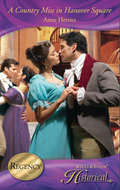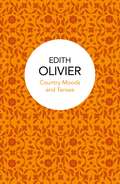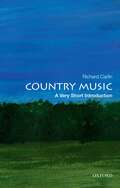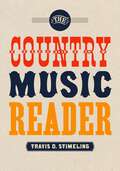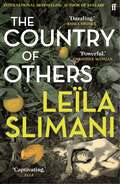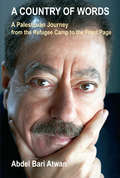- Table View
- List View
The Country Blacksmith (Shire Library #735)
by David L. McDougallThe blacksmith was once crucial to village life, whether commissioned for the humblest repair, the most luxurious ironwork or even the odd anvil marriage. Occupying prime position in the village, the forge attracted custom from miles around and was a hive of industry and social interaction. David L. McDougall here describes the varied work blacksmiths undertook, the tools and techniques they used, and the magical and mystical qualities with which they were associated. If you want to know more about the rise and fall of the country blacksmith – and the recent revival of the craft – this colourfully illustrated book is the ideal introduction.
The Country Blacksmith (Shire Library)
by David L. McDougallThe blacksmith was once crucial to village life, whether commissioned for the humblest repair, the most luxurious ironwork or even the odd anvil marriage. Occupying prime position in the village, the forge attracted custom from miles around and was a hive of industry and social interaction. David L. McDougall here describes the varied work blacksmiths undertook, the tools and techniques they used, and the magical and mystical qualities with which they were associated. If you want to know more about the rise and fall of the country blacksmith – and the recent revival of the craft – this colourfully illustrated book is the ideal introduction.
Country Boy: Growing up in Norforlk 1940-60 (Reminiscence Ser.)
by Colin MillerColin Miller was born in 1940 in Rollesby, a village near Great Yarmouth in the heart of Broadland Norfolk. In Rollesby, as in so many other rural communities at this time, drinking water was from a well, the lavatory was a bucket in an outside privy, transport was a bicycle or a bus and entertainment was provided by the radio, whist drives at the village hall or a rare visit to the cinema.As the 1940s and 50's progressed this way of life altered dramatically, some would say disappeared - and Colin Miller chronicles these changes through the eyes of a Norfolk schoolboy and teenager. Developing themes such as school days, health, work, entertainment, sport and leisure, this honest and thoughtful account also includes brief extracts from the local newspapers, reporting local events and illustrating the social change experienced by the author.Country Boy will bring back many memories for anyone who grew up in rural Britain in the 1940s and '50s - and will also remind subsequent generations of how much life changed in just a couple of decades.
The Country Bride (The Village Secrets #3)
by Dilly CourtThe final book in the heartwarming Village Secrets trilogy from the No.1 Sunday Times bestselling author.
Country Church Monuments
by C. B. NewhamA landmark illustrated history of rural church monuments - the forgotten national treasures of England and WalesDeep in the countryside, away from metropolitan abbeys and cathedrals, thousands of funerary monuments are hidden in parish churches. These artworks - medieval brasses and elegant marble effigies, stone tomb chests and grand mausoleums - are of great historical and cultural significance, but have, due to their relative inaccessibility, faded from accounts of our art history.Over twenty-five years, C. B. Newham FSA has visited and photographed more than eight thousand rural churches, cataloguing the monumental sculptures encountered on his quest. In Country Church Monuments, he presents 365 of the very best, each accompanied by detailed photographs, biographies of both the deceased and their sculptors and a wealth of contextual material. Many of these works commemorate famous historical figures, from scheming Tudor courtier Richard Rich to Victorian prime minister William Ewart Gladstone. But more moving are the countless others - minor aristocrats, small-time industrialists, much-loved mothers, fathers and children - who, if not for their memorials, would wholly be lost to time.As Newham blows the dust off these artworks and breathes life into the stories they tell, a new aesthetic history of rural England and Wales emerges. Country Church Monuments is a poignant record of the art we make at the borders of life and death, of our ceaseless human striving for eternity.
Country Days (Reminiscence Ser.)
by Alice TaylorMemoir from the bestselling author of To School Through the Fields who has been described by The Observer as 'Ireland's Laurie Lee...a chronicler of fading village life and rural rituals who sells and sells'. In this collection she takes her readers along the byways of Ireland and into the heart of the country. In stories by turn comic and poignant, she explores the character of family and friends, testing the bonds of concern and kindness which hold people together.
Country Doctor: Tales Of A Rural Gp
by Dr Michael SparrowHave you ever had to decide what to do with a very large dead body on a Mexican beach, or an unidentified corpse by a Devonian cowshed when the herd is due in for milking? How should you deal with a drug runner rescued from the Caribbean Sea when he pulls a gun on you? And how would you react if one of your patients was abducted by aliens?If you are a GP it seems these are routine matters. From coping with the suicide of a colleague to the unusual whereabouts of a jar of Coleman's mustard, this is the story of one rural doctor's often misguided attempts to make sense of the career in which he has unwittingly found himself.Dr Sparrow's adventures would be utterly unbelievable were they not 100% true stories. His bedside manner may sometimes leave a little to be desired but, if you're in dire straits, this doctor will certainly have you in stitches.
A Country Doctor in the French Revolution: Marie-François-Bernadin Ramel
by Robert WestonThis book will be of interest to those studying French medical and Revolutionary history. It traces the life of an early-modern rural French physician from childhood to death — how he worked as a physician for six years in North Africa (taking a particular interest in medical meteorology); sought to establish himself as a savant in the Republic of Letters by publishing texts and prize-winning essays; and, despite his bourgeois roots, took part in the siege of Toulon, became committed to the ideals of the French Revolution, and volunteered for the Revolutionary armée d’Italie, mainly working in military hospitals. It concludes with an account of his time practicing medicine in southwest France, where he also engaged in local politics, eventually being appointed to a mayoral position by Bonaparte.
A Country Doctor in the French Revolution: Marie-François-Bernadin Ramel
by Robert WestonThis book will be of interest to those studying French medical and Revolutionary history. It traces the life of an early-modern rural French physician from childhood to death — how he worked as a physician for six years in North Africa (taking a particular interest in medical meteorology); sought to establish himself as a savant in the Republic of Letters by publishing texts and prize-winning essays; and, despite his bourgeois roots, took part in the siege of Toulon, became committed to the ideals of the French Revolution, and volunteered for the Revolutionary armée d’Italie, mainly working in military hospitals. It concludes with an account of his time practicing medicine in southwest France, where he also engaged in local politics, eventually being appointed to a mayoral position by Bonaparte.
A Country Girl
by Nancy CarsonA must-read sweeping saga, full of intrigue, romance and page-turning drama . . .
Country House Brewing in England, 1500-1900
by Pamela SambrookUntil the 18th century or even later, beer was the staple drink of most men and women at all levels of society. Tea and coffee were expensive luxuries while water might well carry disease. To supply the needs of both owners and servants, every country house with an accessible source of water had a brewhouse, usually close at hand. Although many of the brewhouses still stand, in some cases with the original brewing vessels (as at Lacock and Charlecote), their habitual conversion to other uses has allowed them to be ignored. Yet they are distinctive buildings - as much part of a country house as an ice-house or stables - which need both to be recognized and preserved. The scale of brewing in country houses, which went on to a surprisingly late date in the 19th century (with odd survivals, such as Hickleton in Yorkshire, in the 20th), was often considerable, if small besides that of commercial brewing. Copious records for both brewing and consumption exist. Pamela Sambrook describes the brewing equipment, such as coppers, mash tuns, underbacks and coolers; the types of beers brewed, from strong ale to small beer, and how they were kept; and the brewers themselves, their skills and attitudes. English Country House Brewing, 1500-1900 shows the role beer played in the life of the country house, with beer allowances and beer money an integral part of servants' rewards. Generous allowances were made for arduous tasks, such as harvesting. For celebrations, such as the heir's coming of age, extra-strong ale was provided. This book, which is heavily illustrated, is an important and original contribution to architectural, brewing and social history.
A Country House Christmas: A Magical Memoir Of An Edwardian Christmas
by Phyllis Elinor SandemanA refreshed reissue of the 1952 classic Treasure on Earth. A vivid and charming account of Christmas in an Edwardian country house.
The Country House Kitchen Garden 1600-1950
by C Anne WilsonCountry house kitchen gardens were designed as perfect ‘grow your own’ environments and ensured that households were supplied with their own fruit and vegetables throughout the year. This book offers an insight into the digging and sowing of these gardens, as well as exploring how walled gardens contributed towards a sustainable lifestyle and often were a source of not just food, but also of natural medicines. A wealth of contemporary illustrations, material from archives, gardening manuals, seed catalogues, engravings and other documents, paint a vivid picture of the country house kitchen garden and its development over three and a half centuries. This delightful book recounts an important part of our historic houses and their national heritage – to be enjoyed by gardeners and non-gardeners alike.
The Country House Revealed: A Secret History of the British Ancestral Home
by Dan CruickshankSpanning the architectural history of the country house from the disarming Elizabethan charm of South Wraxall, the classical rigour of Kinross in Scotland, the majesty and ingenuity of Hawksmoor's Easton Neston, the Palladian sweep of Wentworth Woodhouse, with over 300 rooms and frontage of 600 feet, the imperial exuberance of Clandeboye, through to the ebullient vitality of Lutyens' Marshcourt, the stories of these houses tell the story of our nation. All are the are buildings of the greatest architectural interest, each with a fascinating human story to tell, and all remain private homes that are closed to the public. But their owners have opened their doors and allowed Dan Cruickshank to roam the corridors and rummage in the cellars as he teases out the story of each house - who built them, the generations who lived in them, and the families who lost them. Along the way he has uncovered tales of excess and profligacy, tragedy, comedy, power and ambition. And as these intriguing narratives take shape, Dan shows how the story of each house is inseparable from the social and economic history of Britain. Each one is built as a wave of economic development crests, or crumbles. Each one's architecture and design is thus expressive of the aims, strengths and frailties of those who built them. Together they plot the psychological, economic and social route map of our country's ruling class in a rich new telling of our island story.
The Country House Servant
by Pamela A SambrookOne 19th century footman complained about the work involved in drawing more than 40 baths for his household, yet Lady Grenville felt no compunction in describing her footman as a "lazy flunkey". For centuries a large body of domestic servants was an often unappreciated foundation for the smooth running of a household. Today, the warrens of "domestic offices" intrigue visitors. This book makes sense of these and the social structures behind them. It describes the skills, equipment, cleaning methods and work organization of the housemaid, laundrymaid, footman, valet and hall-boy - the servants who spent their days polishing fine furniture, and washing brilliant chandeliers, but also sponging filthy riding habits, and washing babies' nappies. The author also looks at how servants spent their leisure time. One footman enjoyed rowing on the lake every morning before work, while others had to sit up late at night sewing their own work-dresses. Contemporary manuals, diaries, accounts and first hand recollections provide a vivid insight into what life was really like for those in domestic service. A wealth of photographs, engravings and panels illustrate the domestic workings of country houses, many now looked after by the National Trust. This is an absorbing book for social historians and visitors to country houses alike.
Country Houses and Seaside Cottages of the Victorian Era
by William T. ComstockThis fascinating book presents a series of 44 designs for vacation homes of varying styles and sizes, created over a century ago by a select group of New York and New Jersey architects. Many of them are two-story, and most were intended to be built on low-to-medium budgets. All of them reflect the ideals of comfort and charm and state-of-the-art technology of the Victorian period.The original publishers compiled a splendid variety of designs, presented them as "seaside and country houses" and included designs for a Victorian club house, pavilion, school house, and a "small seaside chapel." A total of 200 illustrations -- including perspective views, front and side elevations, and first- and second-story floor plans -- depict these appealing designs. Occasionally the architects have specified construction materials and finishing details such as paint, color, and trim, and in all cases they have included the overall anticipated costs, which range from about $500 to about $9,000.The Victorians, of course, loved architectural embellishments of every kind, and it is no small part of the charm of this book to study the profusion of gables, porches, portholes, dormers, porticoes, chimneys, pinnacles, and more, lavished on even the most modest designs. Above all, the houses and cottages appear to be both comfortable and reassuring, appealing reminders of a gracious age long gone. Those studying and working in the fields of architecture, history, and sociology will find in this wonderful book exuberant examples of a rich and charming architectural style. Those who wish to join the growing number of home builders and restorers re-creating Victorian homes will find inspiration in each of these thoughtful designs.
Country houses and the British Empire, 1700–1930 (Studies in Imperialism #116)
by Stephanie BarczewskiCountry houses and the British empire, 1700–1930 assesses the economic and cultural links between country houses and the Empire between the eighteenth and twentieth centuries. Using sources from over fifty British and Irish archives, it enables readers to better understand the impact of the empire upon the British metropolis by showing both the geographical variations and its different cultural manifestations. Barczewski offers a rare scholarly analysis of the history of country houses that goes beyond an architectural or biographical study, and recognises their importance as the physical embodiments of imperial wealth and reflectors of imperial cultural influences. In so doing, she restores them to their true place of centrality in British culture over the last three centuries, and provides fresh insights into the role of the Empire in the British metropolis.
A Country Miss in Hanover Square (A Season in Town #1)
by Anne HerriesLord Pendleton’s Society Wife In her first season in London, country girl Susannah Hampton is confused by the attentions of the dashing Lord Pendleton. Wealthy, but undeniably arrogant, he is certainly not the kind of husband she had in mind. Although she can’t help but find him attractive.
Country Moods and Tenses: A Non-Grammarian’s Chapbook
by Edith Olivier'. . . let the townsman say what he will, country life has more variety . . .'A contemporary of Cecil Beaton, Siegfried Sassoon and Rex Whistler, Edith Olivier is best known for her first book, the novella, The Love Child but was the author of a variety of both fiction and non-fiction, as well as becoming the mayor of Wilton, Wiltshire, in 1939.In this biographical memoir, written during the Second World War and subtitled 'A Non-Grammarian's Chapbook', Olivier takes the five grammatical moods - infinitive, imperative, indicative, subjunctive and conditional - and uses them to describe village and country life in her beloved Wiltshire as it was in 1941, the year of first publication. Covering a range of topics - from the folklore and traditions of the local area, to the weather and landscape itself - Edith Olivier's Country Moods and Tenses captures a moment and describes a world which has, in many ways, been lost to us.
Country Music: A Biographical Dictionary (Very Short Introductions)
by Richard CarlinCountry Music: A Very Short Introduction presents a compelling overview of the music and its impact on American culture. Country music has long been a marker of American identity; from our popular culture to our politics, it has provided a soundtrack to our national life. While traditionally associated with the working class, country's appeal is far broader than any other popular music style. While this music rose from the people, it is also a product of the popular music industry, and the way the music has been marketed to its audience is a key part of its story. Key artists, songs, and musical styles are highlighted that are either touchstones for a particular social event (such as Tammy Wynette's "Stand By Your Man," which produced both a positive and negative backlash as a marker of women's roles in society at the beginning of the liberation movement) or that encompass broader trends in the industry (for example, Jimmie Rodgers' "T for Texas" was an early example of the appropriation of black musical forms by white artists to market them to a mainstream audience). While pursuing a basically chronological outline, the book is structured around certain recurring themes (such as rural vs. urban; tradition vs. innovation; male vs. female; white vs. black) that have been documented through the work of country artists from the minstrel era to today. Truly the voice of the people, country music expresses both deep patriotism as well as a healthy skepticism towards the powers that dominate American society. Country Music: A Very Short Introduction illuminates this rich tradition and assesses its legacy in American popular music culture.
The Country Music Reader
by Travis D. StimelingIn The Country Music Reader Travis D. Stimeling provides an anthology of primary source readings from newspapers, magazines, and fan ephemera encompassing the history of country music from circa 1900 to the present. Presenting conversations that have shaped historical understandings of country music, it brings the voices of country artists and songwriters, music industry insiders, critics, and fans together in a vibrant conversation about a widely loved yet seldom studied genre of American popular music. Situating each source chronologically within its specific musical or cultural context, Stimeling traces the history of country music from the fiddle contests and ballad collections of the late nineteenth and early twentieth centuries through the most recent developments in contemporary country music. Drawing from a vast array of sources including popular magazines, fan newsletters, trade publications, and artist biographies, The Country Music Reader offers firsthand insight into the changing role of country music within both the music industry and American musical culture, and presents a rich resource for university students, popular music scholars, and country music fans alike.
COUNTRY MUSIC READER C
by Travis D. StimelingIn The Country Music Reader Travis D. Stimeling provides an anthology of primary source readings from newspapers, magazines, and fan ephemera encompassing the history of country music from circa 1900 to the present. Presenting conversations that have shaped historical understandings of country music, it brings the voices of country artists and songwriters, music industry insiders, critics, and fans together in a vibrant conversation about a widely loved yet seldom studied genre of American popular music. Situating each source chronologically within its specific musical or cultural context, Stimeling traces the history of country music from the fiddle contests and ballad collections of the late nineteenth and early twentieth centuries through the most recent developments in contemporary country music. Drawing from a vast array of sources including popular magazines, fan newsletters, trade publications, and artist biographies, The Country Music Reader offers firsthand insight into the changing role of country music within both the music industry and American musical culture, and presents a rich resource for university students, popular music scholars, and country music fans alike.
Country Music: A Very Short Introduction (Very Short Introductions)
by Richard CarlinCountry Music: A Very Short Introduction presents a compelling overview of the music and its impact on American culture. Country music has long been a marker of American identity; from our popular culture to our politics, it has provided a soundtrack to our national life. While traditionally associated with the working class, country's appeal is far broader than any other popular music style. While this music rose from the people, it is also a product of the popular music industry, and the way the music has been marketed to its audience is a key part of its story. Key artists, songs, and musical styles are highlighted that are either touchstones for a particular social event (such as Tammy Wynette's "Stand By Your Man," which produced both a positive and negative backlash as a marker of women's roles in society at the beginning of the liberation movement) or that encompass broader trends in the industry (for example, Jimmie Rodgers' "T for Texas" was an early example of the appropriation of black musical forms by white artists to market them to a mainstream audience). While pursuing a basically chronological outline, the book is structured around certain recurring themes (such as rural vs. urban; tradition vs. innovation; male vs. female; white vs. black) that have been documented through the work of country artists from the minstrel era to today. Truly the voice of the people, country music expresses both deep patriotism as well as a healthy skepticism towards the powers that dominate American society. Country Music: A Very Short Introduction illuminates this rich tradition and assesses its legacy in American popular music culture.
The Country of Others
by Leïla Slimani'Dazzling.' Emma Stonex'Exceptional.' Salman Rushdie'Powerful.' Christine Mangan'Captivating.' Elle1944. After the Liberation, Mathilde leaves France to join her husband in Morocco. But life here is unrecognisable to this brave and passionate young woman. Her life is now that of a farmer's wife - with all the sacrifices and vexations that brings. Suffocated by the heat, by her loneliness on the farm and by the mistrust she inspires as a foreigner, Mathilde grows increasingly restless. As Morocco's struggle for independence intensifies, Mathilde and her husband find themselves caught in the crossfire.
A Country of Words: A Palestinian Journey from the Refugee Camp to the Front Page
by Abdel Bari AtwanFew lives reflect their times as much as the life of Abdel Bari Atwan. Born in a refugee camp in Gaza in 1950, he left age seventeen and has since become one of the world's most foremost commentators on the Middle East. In this revealing memoir, Atwan recounts with humour and honesty his extraordinary journey. He depicts both the horror of camp massacres and the unexpected consequences of Britain's involvement in the region - such as when a British paratrooper fell from the sky with his sizeable parachute and everyone in his mother's village got new silk trousers. Atwan shares his many extraordinary encounters, including tea with Margaret Thatcher, a weekend with Osama bin Laden, intimate meetings with Yasser Arafat, and the row between Colonel Gaddafi and the Shah of Iran that earned him his first journalistic break. But his is also a touching, personal story, never more so than when he describes taking his British-born children to meet his family, who still live in a camp surrounded by barbed wire. 'This portrait of the life and times of a distinguished journalist offers a penetrating insight into the world as seen from the point of view of someone born and bred a Palestinian refugee in a Gaza camp. Abdel Bari Atwan's authentic voice and sharp, descriptive writing brings alive a childhood full of life-affirming sparkle amid a lifetime spent deep in the travails of the Middle Eastern tragedy' Polly Toynbee 'Atwan's enthralling memoir charts his meteoric rise form the shoeless urchin in the 1950's to cultured commentator whose opinion is now sought all over the world ... A skilful raconteur.' Tribune Magazine
